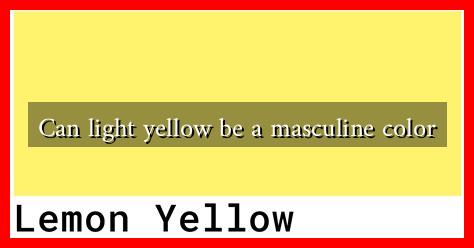-
Table of Contents
Can Light Yellow Be a Masculine Color?
Color perception is a fascinating subject that intertwines psychology, culture, and personal preference. Traditionally, colors have been associated with gender, leading to the question: can light yellow be considered a masculine color? This article explores the cultural implications, psychological effects, and modern trends surrounding light yellow in the context of masculinity.
The Cultural Context of Color and Gender
Colors have long been associated with gender norms. For instance, blue is often seen as a masculine color, while pink is typically viewed as feminine. However, these associations are not universal and can vary significantly across different cultures and time periods. Light yellow, a soft and cheerful hue, has often been relegated to the feminine spectrum. Yet, this perception is evolving.
- Historical Associations: In many Western cultures, yellow has been associated with warmth, happiness, and optimism. However, its lighter shades have often been linked to softness and delicacy, traits traditionally associated with femininity.
- Global Perspectives: In some cultures, yellow is a symbol of strength and power. For example, in ancient Egypt, yellow was associated with the sun god Ra, representing vitality and masculinity.
The Psychology of Color
Color psychology plays a significant role in how we perceive colors and their meanings. Light yellow, in particular, evokes feelings of happiness and energy. According to a study published in the journal “Color Research and Application,” colors can influence mood and behavior, suggesting that light yellow can promote a sense of optimism and creativity.
- Positive Associations: Light yellow is often linked to feelings of joy and cheerfulness, which can be appealing to individuals regardless of gender.
- Neutrality and Versatility: Light yellow can serve as a neutral backdrop, making it suitable for various contexts, including fashion, interior design, and branding.
Modern Trends in Masculinity and Color
In recent years, the concept of masculinity has evolved significantly. The rigid boundaries that once defined masculine and feminine colors are becoming increasingly blurred. Designers and brands are embracing a more inclusive approach to color, allowing for a broader interpretation of what is considered masculine.
- Fashion Industry: Many fashion designers are incorporating light yellow into men’s collections. For instance, brands like Gucci and Prada have featured light yellow in their menswear lines, challenging traditional color norms.
- Interior Design: Light yellow is gaining popularity in men’s interior design choices. It can create a warm and inviting atmosphere without compromising masculinity.
Case Studies and Examples
Several case studies illustrate the growing acceptance of light yellow as a masculine color. For example, the 2021 Spring/Summer collections from various fashion houses showcased light yellow in men’s clothing, signaling a shift in color perception. Additionally, brands like Nike and Adidas have released athletic wear featuring light yellow, appealing to a broader audience.
Moreover, social media platforms have played a crucial role in reshaping color norms. Influencers and public figures are increasingly seen wearing light yellow, promoting its acceptance as a color for all genders. This shift is reflected in the growing number of hashtags like #MenInYellow on platforms like Instagram, showcasing men confidently wearing this vibrant hue.
Conclusion
In conclusion, light yellow can indeed be a masculine color, especially as societal norms continue to evolve. The traditional associations of colors with gender are becoming less rigid, allowing for a more inclusive understanding of color. As seen in fashion, interior design, and social media, light yellow is increasingly embraced by men, reflecting a broader acceptance of diverse expressions of masculinity.
Ultimately, color is a personal choice, and individuals should feel empowered to wear and use colors that resonate with them, regardless of societal expectations. As we move forward, it is essential to celebrate this diversity and recognize that colors like light yellow can embody strength, creativity, and individuality for everyone.
For more insights on color psychology and its impact on design, you can visit Color Psychology.




